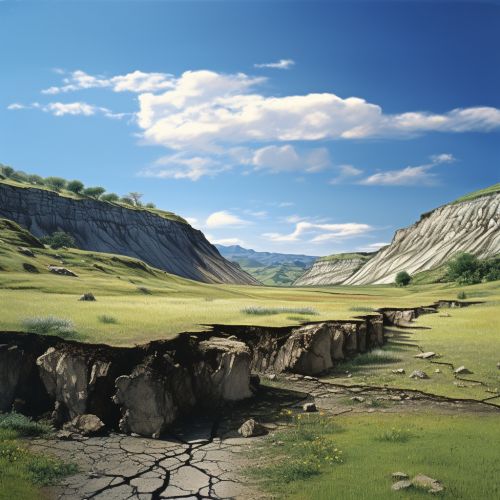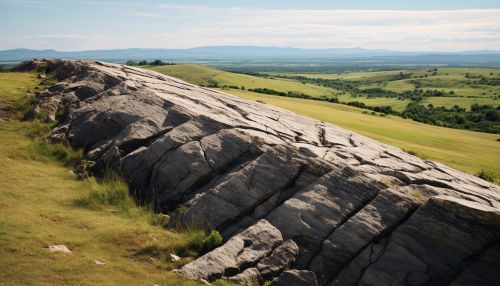Fault (geology)
Introduction
A fault in geology is a planar fracture or discontinuity in a volume of rock across which there has been significant displacement due to rock-mass movement. Large faults within the Earth's crust result from the action of plate tectonic forces, with the largest forming the boundaries between the plates, including subduction zones or transform faults.
Types of Faults
There are three main types of faults: Normal, Reverse, and Strike-Slip. Each of these faults is characterized by the type of stress that causes them and the movement of the rock on either side of the fault line.
Normal Faults
Normal faults occur when the crust is extended. This happens when the rock above the fault moves down relative to the rock below it. These faults are common in areas of the crust where extension is occurring, such as at the Mid-Atlantic Ridge.


Reverse Faults
Reverse faults, also known as thrust faults, occur when the crust is being compressed. In these faults, the rock above the fault moves up relative to the rock below it. These faults are common in areas of the crust where compression is occurring, such as at the edges of tectonic plates.
Strike-Slip Faults
Strike-slip faults occur when the crust is being sheared. In these faults, rocks on either side of the fault move horizontally past each other. These faults are common in areas of the crust where shear stress is occurring, such as along transform boundaries.
Fault Mechanics
Fault mechanics is a field of study dedicated to understanding how faults form in the Earth's crust and how they move. This involves studying the forces that cause the movement of the faults, the frictional properties of the faults, and the effects of the movement on the surrounding rock.
Stress and Strain
Faults form in response to stress and strain in the Earth's crust. Stress is the force applied to a rock, and strain is the deformation that results from this stress. When the stress on a rock exceeds its strength, a fault can form.
Friction
Friction plays a critical role in fault mechanics. The frictional properties of the rock along the fault line can determine how the fault moves. For example, if the friction is low, the fault can slip easily, leading to an earthquake. On the other hand, if the friction is high, the fault may not move at all, or it may move slowly in a process known as creep.
Seismic Waves
When a fault slips rapidly, it can generate seismic waves that propagate through the Earth. These waves can be detected by seismometers and are used to study earthquakes and the interior structure of the Earth.
Faults and Earthquakes
Faults are closely associated with earthquakes, which occur when stress on a fault is released suddenly, causing the rocks on either side of the fault to move. The size of an earthquake is related to the area of the fault that slips and the amount of slip along the fault.
Earthquake Prediction
Predicting when and where earthquakes will occur is a major focus of earthquake research. While it is currently impossible to predict the exact time and location of an earthquake, scientists can estimate the probability of an earthquake occurring in a certain area over a certain period of time based on the history of earthquakes in the area and the rate at which stress is accumulating on the faults.
Earthquake Hazards
Earthquakes can cause significant damage to buildings, infrastructure, and human life. The shaking caused by earthquakes can lead to landslides, tsunamis, and ground rupture. Understanding the location and behavior of faults is critical to assessing and mitigating these hazards.
